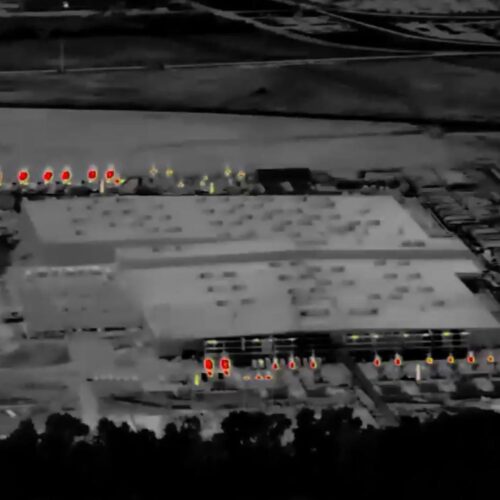Can the US’s system to monitor air pollutants keep up with a changing climate?
The Downtown Manhattan skyline stands shrouded in a reddish haze as a result of Canadian wildfires on June 6, 2023. Credit: Lokman Vural Elibol/Anadolu Agency via Getty Images
Ten years ago, Tracey Holloway, an atmospheric scientist at the University of Wisconsin–Madison, would have said that air pollution in the United States was a huge success story. “Our air had been getting cleaner and cleaner almost everywhere, for almost every pollutant,” she said. But in June 2023, as wildfire smoke from Canada spread, the air quality dropped to historically low levels in her home state of Wisconsin.
Just last month, the region’s air quality dipped once more to unhealthy levels. Again, wildfires were to blame.
While the US has made significant strides in curbing car and industrial pollution through setting emission limits on industrial facilities and automakers, the increasing frequency and intensity of fires are “erasing the gains that we have obtained through this pollutant control effort,” said Nga Lee “Sally” Ng, an aerosol researcher at Georgia Institute of Technology.
The changing dynamics present a challenge for both residents and researchers tracking air quality. Many of the high-quality monitors used to measure pollution reside near large cities and stationary sources, such as coal-powered plants, and don’t cover the US uniformly. Regions that lack such stations are called air quality monitoring deserts, and they may leave vulnerable populations in the dark about their local conditions.
The current infrastructure also isn’t set up to fully account for the shifting behavior of wildfire smoke, which can travel hundreds of miles or more from fire sources to affect air quality and public health in distant communities. That smoke can also include toxins, such as lead when cars and homes burn.
“Fires are really changing the story,” said Holloway.
Since the introduction of the Air Pollution Control Act of 1955, air quality has been recognized as a national issue in the United States. Then with the enactment of the Clean Air Act in 1970 and following amendments, researchers and federal agencies began to monitor the level of pollutants, particularly carbon monoxide, nitrogen dioxide, ozone, particulate matter, and sulfur dioxide, to identify if these were up to the established National Ambient Air Quality Standards.
The Environmental Protection Agency uses these pollutant levels to calculate an air quality index, or AQI, a numerical and color-coded system scaled from 0 to 500 that informs the public how safe the air is. Higher numbers, associated with red, purple, and maroon, indicate worse quality; in June 2023, for example, parts of Wisconsin topped 300, indicating “hazardous” air. All residents were advised to stay indoors as much as possible.
The EPA and other federal agencies make use of various networks of advanced ground monitors that can pick up on different air pollutants, and many experts say that the US has one of the most advanced air quality tracking systems in the world.
Still, there are gaps: Regulatory monitors cost around $50,000 upfront and require continuous maintenance, so states place them in locations where researchers expect pollution may be high. Currently, there are 4,821 active monitors across the US in the EPA’s AirData system—many of which were installed in the 1990s and 2000s—but they are more likely to be near more populated areas and in states in the West and Northeast, creating air quality monitoring deserts elsewhere, according to a new study published in April.
When looking at their distribution, researchers at The Pennsylvania State University found that 59 percent of US counties—home to more than 50 million people—lacked an air quality monitoring site. Many of those air quality monitoring deserts were in rural areas in the South and Midwest. Counties with higher poverty rates and a higher concentration of Black and Hispanic residents were also more likely to be air quality monitoring deserts when accounting for population.
Similarly, a Reuters investigation found that 120 million Americans live in counties that have no monitors for small particle pollution and that in 2020, “the government network of 3,900 monitoring devices nationwide has routinely missed major toxic releases and day-to-day pollution dangers,” including those linked to refinery explosions. (In response to a request for comment, an EPA spokesperson noted that the agency “continues to work closely with state, local, and tribal monitoring programs to expand the use of air sensors to improve measurement coverage, which provide near-real time data to a number of publicly available sources, such as the AIRNow Fire and Smoke Map.”)
These gaps in coverage can be accentuated with wildfires, which often originate in sparsely populated areas without monitor coverage. Wildfires can also be unpredictable, making it difficult to identify priority sites for new monitors. “You certainly can’t anticipate what areas are going to see wildfire smoke,” said Mary Uhl, executive director of Western States Air Resources Council, which shares air quality information across 15 western state air agencies. Meanwhile, wildfire pollutants can spread widely from their original source, and smoke particles can sometimes travel for up to 10 days, Ng pointed out.
Such shifting dynamics are driving researchers to expand their monitoring infrastructure and complement it with crowdsourced and satellite data to capture the widespread pollution. “There will be potential to increase the spatial covering of these monitoring networks,” said Ng. “Because, as you can see, we could still make use of better measurement, maybe at the different community level, to better understand the air that we are being exposed to.”
To expand coverage in a cost-efficient way, agencies are investigating a variety of different approaches and technologies. Low-cost monitors now allow people to crowdsource data about air quality in their communities. (However, these tend to be less precise and accurate than the high-grade instruments.) State, local, and tribal agencies also play a critical role in monitoring air quality, such as New York’s Community Air Monitoring Initiative, which tracked pollution for a year using mobile monitoring in 10 disadvantaged communities with high air pollution burdens. And the EPA has a pilot program that loans compact mobile air monitoring systems to air quality professionals, who can set them up in their vehicles to map air quality during and after wildfires.
Satellites can also provide critical information since they can estimate levels of gases and pollutants, providing data about where pollution levels are highest and how pollutants are transported. “We can see where we’re missing things in those deserts,” said Uhl.
This strategy might be helpful to address the challenge with wildfires because satellites can get a more global view of the spread of pollutants. Fires “change season to season, so they’re not always coming from the same place,” said Holloway, who leads a team that uses NASA satellite data to monitor air quality. “And I think really what you need is a way of evaluating what’s going on over a wide area. And these satellites up in space, I think, offer exactly the tool for the job.”
Other advancements allow scientists to study the composition of pollution more granularly, since different pollutants can have different toxicities and health effects. For example, particulate matter 2.5, or PM2.5—which has a diameter of 2.5 micrometers or less—can cause respiratory and heart problems. Ng led the establishment of a system called ASCENT, or the Atmospheric Science and Chemistry Measurement Network, which measures the specific chemical constituents in PM2.5 to identify which particles might be the most toxic to human health, along with aiming to answer many other scientific questions.
After the Eaton Canyon and Palisades fires that burned across Los Angeles County in January 2025, Ng and colleagues used the system and identified that lead concentration increased approximately 110 times over the average levels, likely due to the ignition of the lead-ridden vehicles, plastics, buildings, and other fuel. The system works as a “magnifying glass to look into PM2.5,” said Ng. Currently, they have 12 sites and hope to expand ASCENT to more locations in the future if resources are available.
Different approaches to collecting air quality monitoring data, along with computational modeling, could be combined to improve researchers’ understanding of air pollution and expand air quality information to underserved populations, said Holloway.
Today, although wildfires represent a new challenge, “we have all these additional tools to help us understand air quality,” said Uhl. “And in the end, that’s what we want to do: We want to understand it. We want to be able to have some ideas, some ways to predict it, to ultimately protect public health.”
This article was originally published on Undark. Read the original article.




